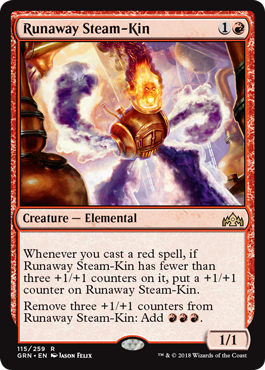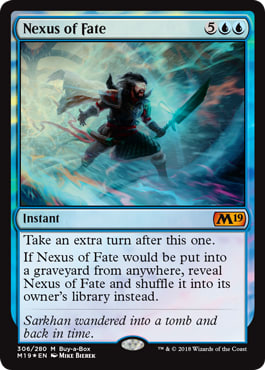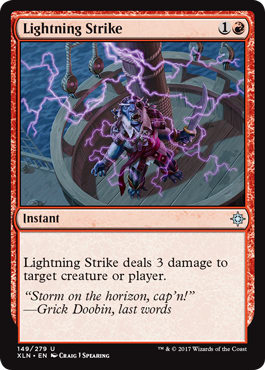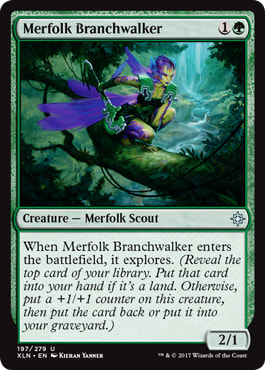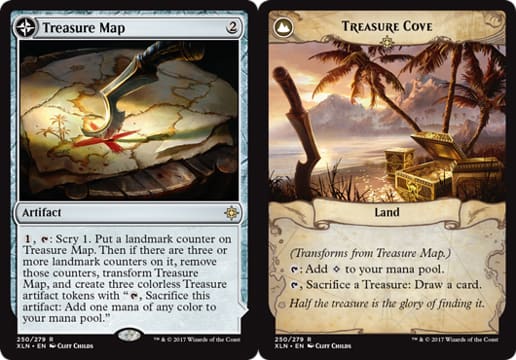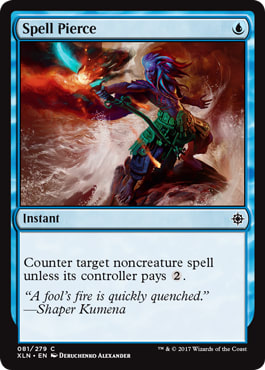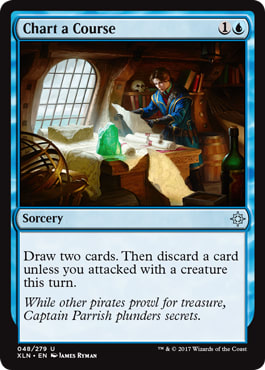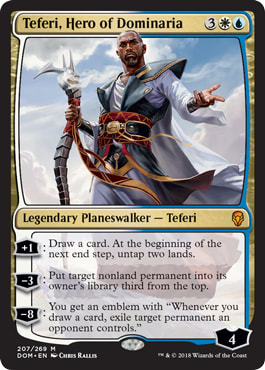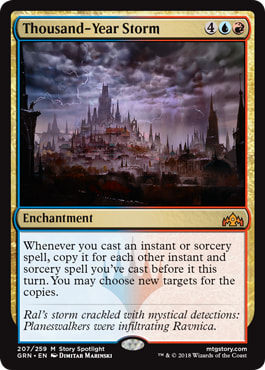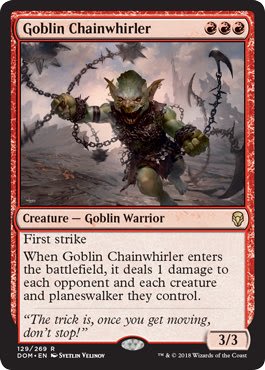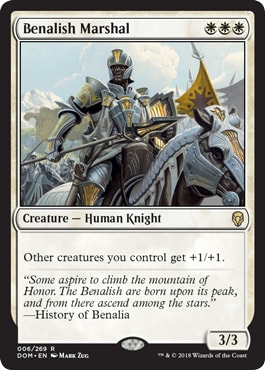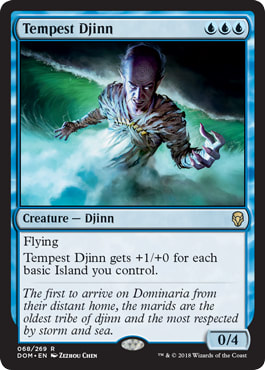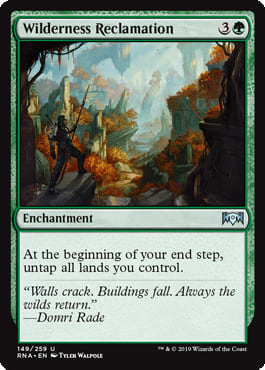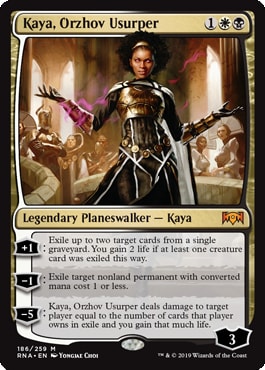Best of one Constructed is a strange animal.
The first ladder season on MTG Arena was run as best of one, resulting in many very polarized opinions about the format. Some loved how quick and easy at was, while many more decried it as "not real Magic."
Without the fear of being hit by devastating sideboard cards, linear strategies were rampant. With Mono-Red Aggro already being a good Standard deck and Nexus of Fate decks being great in Game 1s (before players got access things like Duress and Negate) each was very prevalent, creating a very jarring experience for players who have been playing with sideboards for upwards of two decades.
Now we have just finished season two, where Nexus of Fate has been banned in best of one and best of three was also introduced as a concurrent ranked format that shares the same ranking system. It feels like the majority of players, including myself, have moved over to best of three, leaving best of one as somewhat of an enigma.
However, it's an enigma that counts toward your ladder ranking just like best of three does. With high ladder rankings being important for qualifying for real events, examining all options and angles is going to be very important.
This is what led me back to trying best of one.
Only the Top 8 players from season two qualified for the Mythic Invitational yesterday. This article was written before that deadline, so I can only hope that past me was successful after playing all day on Thursday. As of writing this I've been floating around Mythic 100, and with such a difficult task on tap I was looking for an edge. I played a ton of best of one in season one as I slowly ranked up in my Bronze to Mythic series on my stream, and while it can be frustrating it's also a fairly under-explored format.
Today I'm here to tell you everything I know about best of one Standard on MTG Arena.
It Is Unexplored Relative To Best Of Three
Perhaps the biggest reason to explore best of one over best of three is the relative lack of information available on it compared to best of three. Best of one is a completely different animal than best of three, and if you try to just play decks from the recent Mythic Championship in best of one you're going to be handicapping yourself right from the start.
With a Mythic Championship in the books and more content on it than you could ever hope to get through in a lifetime, you're unlikely to be able to get a leg up in best of three any more than just learning a good deck and hoping to play it better than your equally informed opponents. That's fine, but best of one is going to offer you much higher chance of being able to beat your opponents in the deck-building stage as well as the gameplay stage.
Put mildly, best of one feels exploitable.
Linear Strategies Reign Supreme
It feels awful to have a Lava Coil when they have Teferi, Hero of Dominaria or a Cast Down when they have Lyra Dawnbringer, but Skymarcher Aspirant always attacks for two and Lightning Strike always deals three damage.
Dave Price is a godfather of Magic theory, and his maxim holds even more weight in best of one.
By putting the pressure on you opponents you absolve yourself of the responsibility of needing to select the correct answers. It's no coincidence that linear decks tend to do much better in Game 1s and midrange and control decks tend to do better in post-sideboard games. Those decks get to further adapt themselves to their enemy and come up with the perfect answers.
You don't get to do that in best of one, meaning perfect answers don't exist.
This is a big reason why aggressive decks tend to do so well in best of one. Put the pressure on your opponent to have the answers by asking the toughest questions you can.
Decks Are Naturally More Consistent
However, that's not the only reason why aggressive decks are so popular in best of one. A lot of that also has to do with how MTG Arena handles opening hands in best of one:
This means a few things. Obviously this means that you will mulligan way less than normal, but easy to miss is that you're usually going to have a very solid and smooth opener almost every game. There's nothing that hurts aggressive decks more than fumbling out of the gates and this special rule mitigates that. Even more in aggressive deck's favor is how this lets you cheat on lands. You get to shave a land or two from your deck, further increasing top deck potential in the midgame.
With your average opening hand looking much better and the promise of smooth curves and low land counts, consistency elements like Merfolk Branchwalker and Treasure Map end up looking much less appealing. Why spend mana in the early game to smooth out your draw when it's already buttery smooth?
Mana Efficiency Is Extremely Important
With less of a focus on early game setup and more of a focus on curving out, mana efficiency becomes extremely important.
If you're going to interact you're going to want to do it early and often, hopefully while doing other things as well. This makes one-mana interactive spells like Spell Pierce go from "situationally playable" to "format staple" very fast. Even something as simple as Fungal Infection can have a very major impact early in the game and those early turn blowouts are everything.
Of course it's also apparent that these sorts of cards are good against aggressive linear decks, giving you another reason to be interested in them. Cards like Ravenous Chupacabra and Ixalan's Binding are far too slow and clunky to mess with. Be efficient!
Reactive Cards Are A Liability
Of course, there's also the problem of drawing the wrong reactive cards at the wrong times.
If you try and pack your deck with removal spells like Lava Coil and Cast Down to beat the linear aggressive decks that will work sometimes... until you play against an Esper Control deck or a Temur Reclamation deck that has no creatures and you draw three dead cards and die. Lava Coil is a much better card in best of three on average, but in best of one playing something like Lightning Strike is often safer. Try to make sure your cards always do something, even in awkward scenarios.
This also puts a premium on cards that can help to filter through dead cards. Cards like Chart a Course or Rix Maadi Reveler can turn those dead cards into new ones, as can jumpstart cards like Chemister's Insight. You can't waste too much time trying to craft your hand, but having access to these sorts of effects incidentally is excellent.
"Glass Cannon" Or "Cheese" Strategies Are Legitimate
In Starcraft 2, "cheese" strategies involve doing something outlandish and unexpected in the early game to try and get a cheap win, the most popular example being the 12 pool Zergling rush that's become a piece of popular culture. Instead of devolving a normal strategy, you go completely all in on an early attack and if it fails you are almost guaranteed to lose because you set yourself so far back. Think Goblin Charbelcher decks in Legacy or Eight Whack in Modern.
Would you consider Esper Control a cheese strategy?
It sounds weird, but we've all felt the pain of playing against a creature-less control deck in a Game 1 and drawing all of our dead removal spells. This of course changes for Game 2 and three once you can sideboard, but without that option the creature-less control deck can effectively cheese you out of a win because they did something you weren't expecting.
This also means that creature-less combo decks based around a gimmicky card can sneak away with victories by giving their opponent a bunch of dead cards and doing something out of left field that is unexpected. With it being hard to field that many reactive cards in your deck, and even more pressure to find the right ones, playing a card that people can't interact well with and can't sideboard against is much more effective than normal.
Of course Nexus of Fate was the extreme example of this and a large part of why it got banned.
The Metagame
With all of this in mind, the metagame starts to come together.
Mono-Red is by far the most popular deck and you can expect to play against it in maybe a quarter of your matches. It's just too good, too linear, loves the lower land count, and is able to play ample removal that can just go to the face when it's dead. Mono-White Aggro and Mono-Blue Aggro aren't that far behind, providing solid and proactive strategies.
On the other half of the spectrum is people trying to play the "no creatures" game with either Esper Control or various Wilderness Reclamation decks. This creates the polar divide that makes it difficult to try and play any sort of reactive deck. Cards that are good against these decks are usually very bad against Mono-Red Aggro and vice versa. This is usually the crux of best of one play.
Sultai Midrange, the most popular deck at the recent Mythic Championship, is almost nowhere to be seen in best of one, as it is a clunky and reactive deck that fails most of the tests we've laid out today. It wastes time trying to be consistent with explore creatures, has many expensive spells, and is capable of having the wrong answers at the wrong times.
It's a tough egg to crack, but it feels breakable.
Sample Decks
This is the deck I've been doing most of my damage with over the last few days:
The Orzhov Solution | Best Of One Standard | Jim Davis
- Creatures (18)
- 2 Venerated Loxodon
- 4 Basilica Bell-Haunt
- 4 Dauntless Bodyguard
- 4 Knight of Malice
- 4 Tithe Taker
- Planeswalkers (4)
- 2 Ajani, Adversary of Tyrants
- 2 Kaya, Orzhov Usurper
- Instants (9)
- 3 Cast Down
- 3 Fungal Infection
- 3 Mortify
- Enchantments (7)
- 3 Legion's Landing
- 4 History of Benalia
- Lands (22)
- 7 Plains
- 5 Swamp
- 2 Forsaken Sanctuary
- 4 Godless Shrine
- 4 Isolated Chapel
It follows most of the basic principles we've laid out:
- Basically presideboarded for Mono-Red Aggro and other aggro
- Enough of an aggressive curve to put pressure on your opponents
- A small amount of cheap and mana efficient interaction
- Flexible threats that are good in multiple scenarios
Sure it sucks to have Cast Down and Fungal Infection against a creatureless deck, but we've still got a solid aggressive curve to pressure them and our other interactive elements like Mortify and Kaya, Orzhov Usurper are very live.
Speaking of Kaya, she is a rock star in best of one. She's exceptionally good against all the mono colored aggressive decks, while helping to gain life against mono red and present a different angle of attack against control decks. Eating graveyards is also great against Rekindling Phoenix, Arclight Phoenix, and more!
If you want to see more of this deck check back on Monday for a video on it!
Turbo Niv | Best Of One Standard | Jim Davis
- Creatures (10)
- 2 Murmuring Mystic
- 4 Niv-Mizzet, Parun
- 4 Sailor of Means
- Instants (13)
- 2 Dive Down
- 3 Spell Pierce
- 4 Opt
- 4 Shock
- Sorceries (10)
- 2 Fiery Cannonade
- 4 Chart a Course
- 4 Lava Coil
- Artifacts (4)
- 4 Treasure Map
- Lands (23)
- 8 Island
- 6 Mountain
- 1 Highland Lake
- 4 Steam Vents
- 4 Sulfur Falls
This was the deck I did the most damage with in my Bronze to Mythic series before Ravnica Allegiance came out, and while it is more reactive it has a very clear and linear plan of "play Niv-Mizzet, Parun as soon as humanly possible." All of our cards work toward that goal, as a card like Sailor of Means does a great job blocking against aggressive decks and bridging that gap. We also have Chart a Course to discard dead cards when necessary.
Wrapping Up
Is best of one different than more traditional best of three Magic?
Absolutely!
Does that mean it's "the wrong way to play Magic?"
Absolutely not!
First off, there's no wrong way to play Magic. But more importantly, best of one is providing a unique experience that is being ignored by the game's better players and is ripe for exploitation. With the Mythic ladder being more important than ever, it is important to explore all options and best of one is just that, another option.
Good luck!
















